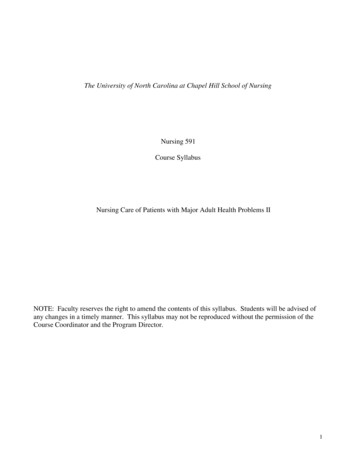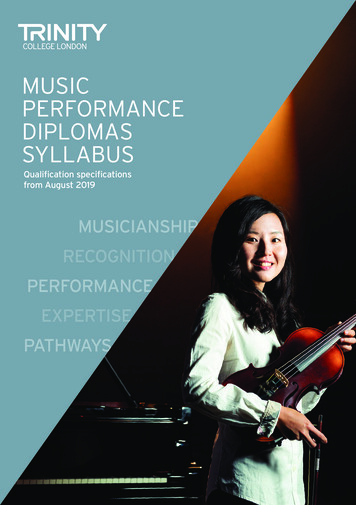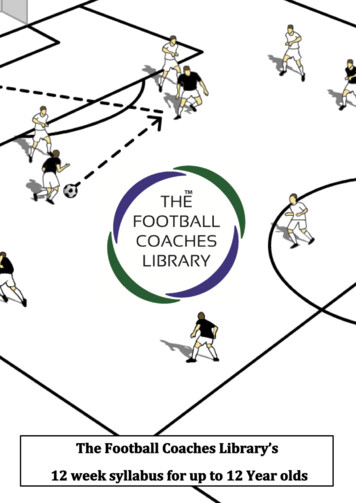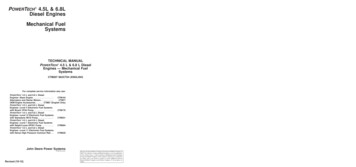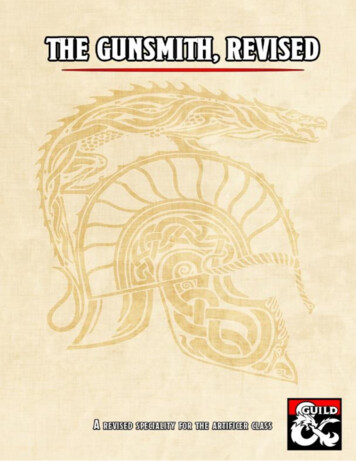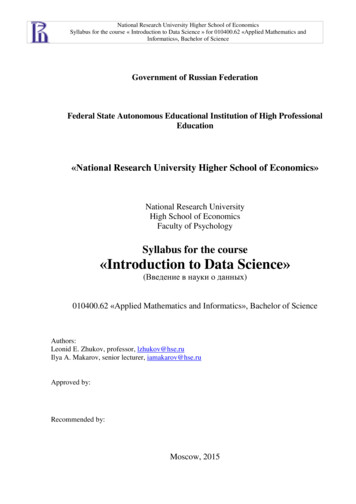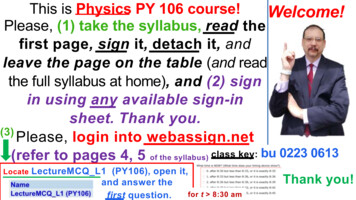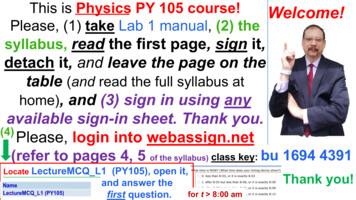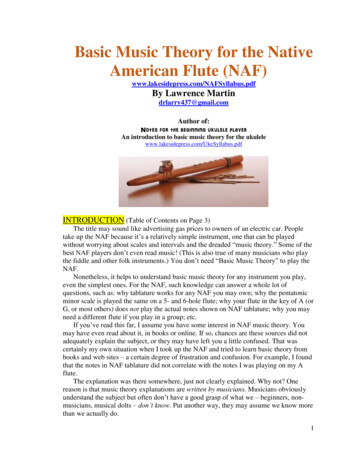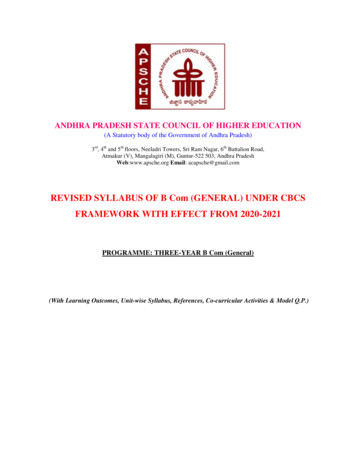
Transcription
ANDHRA PRADESH STATE COUNCIL OF HIGHER EDUCATION(A Statutory body of the Government of Andhra Pradesh)3rd, 4th and 5th floors, Neeladri Towers, Sri Ram Nagar, 6th Battalion Road,Atmakur (V), Mangalagiri (M), Guntur-522 503, Andhra PradeshWeb:www.apsche.org Email: acapsche@gmail.comREVISED SYLLABUS OF B Com (GENERAL) UNDER CBCSFRAMEWORK WITH EFFECT FROM 2020-2021PROGRAMME: THREE-YEAR B Com (General)(With Learning Outcomes, Unit-wise Syllabus, References, Co-curricular Activities & Model Q.P.)
ANDHRA PRADESH STATE COUNCIL OF HIGHER EDUCATION(A Statutory body of the Government of Andhra Pradesh)CBCS – UG SYLLABUS SUBJECT REVIEW COMMITTEE(To be implemented from the Academic Year 2020-21)PROGRAMME: Three-Year BCom (General and Computer Applications)Domain Subject: Commerce(Syllabus with Outcomes, Co-curricular Activities, References for Fifteen Courses of 1, 2,3 & 4 Semesters)Structure of COMMERCE Syllabus under CBCS for 3-year B Com Programme (withdomain subject covered during the first 4 Semesters with 15 Courses)CoursesI1AFundamentals of Accounting (Gen & CA)5425752I1BBusiness Organization and Management (Gen & CA)5425753I1CBusiness Environment (Gen)/Information Technology (CA)5425754II2AFinancial Accounting (Gen & CA)5425755II2BBusiness Economics (Gen & CA)5425756II2CBanking Theory &Practice (Gen) /E-commerce and Web Designing (CA)5425757III3AAdvanced Accounting (Gen & CA)5425758III3BBusiness Statistics (Gen & CA)5425759III3CMarketing (Gen)/Programming with C & C (CA)54257510IV4A Corporate Accounting (Gen & CA)54257511IV4B54257512IV4C Income Tax (Gen & CA)54257513IV4DBusiness Laws (Gen & CA)54257514IV4EAuditing (Gen &CA)54257515IV4FGoods and Service Tax (Gen)/Data Base Management System (CA)54257575603751125CodeSemMarks1Sl.NoName of Course(Each Course consists 5 Units with each Unithaving 12 hours of class-work)Cost and Management Accounting (Gen & CA)Total(Gen &CA)B Com (General) and B Com (Computer Applications)Hours/WeekCreditsMidSemSemEnd
PROGRAMME: THREE-YEAR B Com(General and Computer Applications)Course Code:Domain Subject: CommerceSemester-wise Syllabus under CBCS(w.e.f. 2020-21 Admitted Batch)I Year B Com (Gen & CA)–Semester – ICourse1A: Fundamentals of AccountingLearning Outcomes:At the end of the course, the student will able to Identify transactions and events that need to be recorded in the books of accounts. Equip with the knowledge of accounting process and preparation of final accounts ofsole trader. Develop the skill of recording financial transactions and preparation of reports inaccordance with GAAP. Analyze the difference between cash book and pass book in terms of balance andmake reconciliation. Critically examine the balance sheets of a sole trader for different accounting periods. Design new accounting formulas & principles for business organisations.Syllabus:Unit-I – IntroductionNeed for Accounting – Definition – Objectives, – Accounting Concepts and Conventions –GAAP - Accounting Cycle - Classification of Accounts and its Rules – BookKeeping andAccounting - Double Entry Book-Keeping - Journalizing - Posting to Ledgers, Balancing ofLedger Accounts (including Problems).Unit-II: Subsidiary Books:Types of Subsidiary Books - Cash Book, Three-column Cash Book- Petty Cash Book(including Problems).
Unit-III: Trial Balance and Rectification of Errors:Preparation of Trial balance - Errors – Meaning – Types of Errors – Rectification of Errors –Suspense Account (including Problems)Unit-IV: Bank Reconciliation Statement:Need for Bank Reconciliation - Reasons for Difference between Cash Book and Pass BookBalances- Preparation of Bank Reconciliation Statement - Problems on both Favourable andUnfavourable Balance (including Problems).Unit -V: Final Accounts:Preparation of Final Accounts: Trading account – Profit and Loss account – Balance Sheet –Final Accounts with Adjustments (including Problems).
References:1. Ranganatham G and Venkataramanaiah, Fundamentals of Accounting, S ChandPublications2. T.S.Reddy& A. Murthy, Financial Accounting, Margham Publications3. S N Maheswari and SK Maheswari, Financial Accounting, Vikas Publications4. R L Gupta & V K Gupta, Principles and Practice of Accounting, Sultan Chand &Sons5. S.P. Jain & K.L Narang, Accountancy-I, Kalyani Publishers6. Tulasian, Accountancy -I, Tata McGraw Hill Co.7. V.K.Goyal, Financial Accounting, Excel Books8. K. Arunjothi, Fundamentals of Accounting; Maruthi Publications9. Prof EChandraiah : Financial Accounting Seven Hills International PublishersSuggested Co-Curricular Activities: Bridge Course for Non-commerce Students Practice of Terminology of Accounting Quiz, Word Scramble Co-operative learning Seminar Co-operative learning Problem Solving Exercises Matching, Mismatch Creation of Trial Balance Visit a firm (Individual and Group) Survey on sole proprietorship and prepare final accounts of concern Group Discussions on problems relating to topics covered in syllabus Examinations (Scheduled and surprise tests) Any similar activities with imaginative thinking beyond the prescribed syllabus
PROGRAMME: THREE-YEAR B COM(General and Computer Applications)Course Code:Domain Subject: CommerceSemester-wise Syllabus under CBCS(w.e.f. 2020-21 Admitted Batch)I Year B Com (Gen & CA) – Semester – ICourse 1B: Business Organization and ManagementLearning Outcomes:At the end of the course, the student will be able to Understand different forms of business organizations. Comprehend the nature of Joint Stock Company and formalities to promote aCompany. Describe the Social Responsibility of Business towards the society. Critically examine the various organizations of the business firms and judge the bestamong them. Design and plan to register a business firm. Prepare different documents to register acompany at his own. Articulatenew models of business organizations.Syllabus:Unit-I –Introduction Concepts of Business, Trade, Industry and Commerce: Business –Meaning, Definition, Features and Functions of Business - Trade Classification – Aids toTrade – Industry Classification and Commerce - Factors Influencing the Choice of Suitableform of OrganisationUnit –II– Forms of Business Organizations: Features,Merits and Demerits of SoleProprietor Ship and Partnership Business - Features Merits and Demits of Joint StockCompanies - Public Sector Enterprises (PSEs) - Multinational Corporations (MNCs)Differences between Private Limited Public Limited Company
Unit-III -Company Incorporation: Preparation of Important Documents for Incorporationof Company - Certificate of Incorporation and Certificate of Commencement of Business Contents of Memorandum and Articles of Association - Contents of ProspectusUnit-IV- Management: Meaning Characteristics - Fayol’s 14 Principles of Management Administration Vs Management - Levels of ManagementUnit-V-Functions of Management: Different Functions of Management - Meaning –Definition – Characteristics Merits and Demits of Planning - Principles of Organisation –Line and staff of Organisation
Reference Books:1. Industrial Organization and Management,C.B.Guptha, Sultan Chand.2. Business Organization - C.D.Balaji and G. Prasad, Margham Publications, Chennai.3. Business Organization -R.K.Sharma and Shashi K Gupta, Kalyani Publications.4. Business Organization & Management: Sharma Shashi K. Gupta, Kalyani Publishers5. Business Organization & Management: C.R. Basu, Tata McGraw Hill6. Business Organization & Management: M.C. Shukla S. Chand,7. Business Organisation and Management, Dr.NeeruVasishth, Tax Mann Publications.8. Business Organisation and Management, Dr B E V L Naidu, Seven Hills InternationalPublishers, HyderabadSuggested Co-Curricular Activities: Book Reading Student Seminars, Debates Quiz Programmes Assignments Co-operative learning Individual / Group Field Studies Group Discussions on problems relating to topics covered by syllabus Collecting prospectus of different companies through media Collection of news reports and maintaining a record of paper-cuttings relating totopics covered in syllabus Talk on current affairs about business, industry etc. Simple project work on development of Certificate of Incorporation, Prospectus andCertificate of commencement of business Biography of well-known management thinkers and managers of giganticcompanies Examinations (Scheduled and surprise tests)
PROGRAMME: THREE-YEAR B COM(General and Computer Applications)Course Code:Domain Subject: CommerceSemester-wise Syllabus under CBCS(w.e.f. 2020-21 Admitted Batch)I Year B Com (Gen & CA) – Semester – ICourse 1C: Business EnvironmentLearning Outcomes:At the end of the course, the student will able to; Understand the concept of business environment. Define Internal and External elements affecting business environment. Explain the economic trends and its effect on Government policies. Critically examine the recent developments in economic and business policies of theGovernment. Evaluate and judge the best business policies in Indian business environment. Develop the new ideas for creating good business environment.SYLLABUS:Unit–I:Overview of Business Environment: Business Environment – Meaning –Characteristics – Scope -Macro and Micro Dimensions of Business Environment Environmental Analysis.Unit – II:Economic Environment: Economic Environment – Nature of the Economy –Structure of Economy – Economic Policies & Planning the Economic Condition – NITIAyog – National Development Council – Five Year Plans
Unit–III: Economic Policies: Economic Reforms and New Economic Policy – NewIndustrial Policy – Competition Law – Fiscal Policy – Objectives and Limitations – MonetaryPolicy and RBIUnit – IV:Social, Political and Legal Environment: Concept of Social Responsibility ofBusiness towards Stakeholders - Demonetisation, GST and their Impact - Political Stability Legal Changes.Unit–V:Global Environment :Globalization – Meaning – Role of WTO – WTO Functions IBRD– Trade Blocks, BRICS, SAARC, ASEAN in Globalisation
Suggested Readings:1. K. Aswathappa : Essentials of Business Environment, Himalaya Publishing House2. Francis Cherunilam : Business Environment,Himalaya Publishing House3. Dr S Sankaran: : Business Environment, MarghamPublications4. S.K. Mishra and V.K. Puri : Economic Environment of Business, HPH5. Rosy Joshi and Sangam Kapoor : Business Environment, Kalyanai Publications6. A C Fernando: Business Environment, Pearson7. Dr V Murali Krishna, Business Environment, Spectrum Publications8. Namitha Gopal, Business Environment, McGraw HillSuggested Co-Curricular Activities: Seminar on overview of business environment Debate on micro v/s macro dimensions of business environment Co-operative learning Seminar on Monetary policies of RBI Debate on social, political and legal environment Group Discussions on Global environment and its impact on business To learn about NITI Ayog and National Development Council Seminars on Economic policies like New Industrial policy, Fiscal policy etc. Reports on WTO,BRICS, SAARC etc. Examinations (Scheduled and surprise tests) on all units
PROGRAMME: THREE-YEAR B COM(General and Computer Applications)Course Code:Domain Subject: CommerceSemester-wise Syllabus under CBCS(w.e.f. 2020-21 Admitted Batch)I Year B Com (Gen & CA)– Semester – IICourse 2A: Financial AccountingLearning Outcomes:At theend of the coursethe student will able to; Understand the concept of consignment and learn the accounting treatment of thevarious aspects of consignment. Analyze the accounting process and preparation of accounts in consignment and jointventure. Distinguish Joint Venture and Partnership and to learn the methods of maintainingrecords under Joint Venture. Determine the useful life and value of the depreciable assets and maintenance ofReserves in business entities. Design an accounting system for different models of businesses at his own using theprinciples of existing accounting system.SyllabusUnit-I:Depreciation: Meaning and Causes of Depreciation - Methods of Depreciation:Straight Line – Written Down Value –Annuity and Depletion Method (including Problems).Unit-II:Provisions and Reserves:Meaning – Provision vs. Reserve – Preparation of BadDebts Account – Provision for Bad and Doubtful Debts – Provision for Discount on Debtors– Provision for Discount on Creditors - Repairs and Renewals Reserve A/c (includingProblems).
Unit-III: Bills of Exchange: Meaning of Bill – Features of Bill – Parties in the Bill –Discounting of Bill – Renewal of Bill – Entries in the Books of Drawer and Drawee(including Problems).Unit-IV: Consignment Accounts: Consignment - Features - Proforma Invoice - AccountSales – Del-credere Commission - Accounting Treatment in the Books of Consigner andConsignee - Valuation of Closing Stock - Normal and Abnormal Losses (includingProblems).Unit-V: Joint Venture Accounts: JointVenture - Features - Difference between JointVenture and Consignment – Accounting Procedure – Methods of Keeping Records–OneVendor Keeps the Accounts and Separate Set off Books Methods (including Problems).
Reference Books:1. Ranganatham G and Venkataramanaiah, Financial Accounting-II, S ChandPublications, New Delhi.2. T. S. Reddy and A. Murthy - Financial Accounting, Margham Publications.3. R.L. Gupta & V.K. Gupta, Principles and Practice of Accounting, SultanChand.4. SN Maheswari and SK Maheswari – Financial Accounting, Vikas Publications.5. S.P. Jain & K.L Narang,Accountancy-I, Kalyani Publishers.6. Tulsan, Accountancy-I, Tata McGraw Hill Co.7. V.K. Goyal, Financial Accounting, Excel Books8. T.S. Grewal, Introduction to Accountancy, Sultan Chand & Co.9. Haneef and Mukherjee, Accountancy-I, Tata McGraw Hill.10. Arulanandam and Ramana, Advanced Accountancy, Himalaya Publishers.11. S.N.Maheshwari&V.L.Maheswari, Advanced Accountancy-I, Vikas Publishers.12. Prof E Chandraiah, Financial Accounting, Seven Hills International Publishers.Suggested Co-Curricular Activities: Quiz Programs Problem Solving Exercises Co-operative learning Seminar Group Discussions on problems relating to topics covered by syllabus Reports on Proforma invoice and account sales Visit a consignment and joint venturefirms(Individual and Group) Collection of proforma of bills and promissory notes Examinations (Scheduled and surprise tests) Any similar activities with imaginative thinking beyond the prescribed syllabus
PROGRAMME: THREE-YEAR B COM(General and Computer Applications)Course Code:Domain Subject: CommerceSemester-wise Syllabus under CBCS(w.e.f. 2020-21 Admitted Batch)I Year B Com (Gen & CA)– Semester – IICourse 2B: Business EconomicsLearning Outcomes:At the end of the course, the student will able to; Describe the nature of economics in dealing with the issues of scarcity of resources. Analyze supply and demand analysis and its impact on consumer behaviour. Evaluate the factors,such as production and costs affecting firmsbehaviour. Recognize market failure and the role of government in dealing with those failures. Use economic analysis to evaluate controversial issues and policies. Apply economic models for managerial problems, identify their relationships, andformulate the decision making tools to be applied for business.SyllabusUnit-I: Introduction: Meaning and Definitions of Business Economics - Nature and Scopeof Business Economics -Micro and Macro Economics and their Interface.Unit-II: Demand Analysis: Meaning and Definition of Demand – Determinants to Demand–Demand Function -Law of Demand – Demand Curve – Exceptions to Law of Demand Elasticity of Demand – Measurements of Price Elasticity of DemandUnit – III: Production, Cost and Revenue Analysis: Concept of Production Function –Law of Variable Proportion -Law of Returns to Scale - Classification of Costs -Break EvenAnalysis - Advantages
Unit-IV: Market Structure: Concept of Market – Classification of Markets -PerfectCompetition – Characteristics – Equilibrium Price -Monopoly – Characteristics – EquilibriumUnder Monopoly.Unit-V: National Income:Meaning – Definition – Measurements of National Income Concepts of National Income -Components of National Income-Problems in MeasuringNational Income
References:1. Business Economics -S.Sankaran, Margham Publications, Chennai.2. Business Economics - Kalyani Publications.3. Business Economics - Himalaya Publishing House.4. Business Economics - Aryasri and Murthy, Tata McGraw Hill.5. Business Economics -H.L Ahuja, Sultan Chand & Sons6. Principles of Economics -Mankiw, Cengage Publications7. Fundamentals of Business Economics -Mithani, Himalaya Publishing House8. Business Economics -A.V. R. Chary, Kalyani Publishers, Hyderabad.9. Business Economics -Dr K Srinivasulu, Seven Hills International Publishers.Suggested Co-Curricular Activities: Assignments Student Seminars Quiz , JAM Study Projects Group Discussion Graphs on Demand function and demand curves Learning about markets The oral and written examinations (Scheduled and surprise tests), Market Studies Individual and Group project reports, Annual talk on union and state budget Any similar activities with imaginative thinking beyond the prescribed syllabus
PROGRAMME: THREE-YEAR B COM(General and Computer Applications)Course Code:Domain Subject: CommerceSemester-wise Syllabus under CBCS(w.e.f. 2020-21 Admitted Batch)I Year B Com (Gen)– Semester – IICourse 2C:Banking Theory and PracticeLearning Outcomes:At the end of the course, the student will able to; Understand the basic concepts of banks and functions of commercial banks. Demonstrate an awareness of law and practice in a banking context. Engage in critical analysis of the practice of banking law. Organize information as it relates to the regulation of banking products and services. Critically examine the current scenario of Indian Banking system. Formulate the procedure for better service to the customers from various bankinginnovations.Syllabus:Unit-I: Introduction:Meaning & Definition of Bank – Functions of Commercial Banks – Credit Creation withExamples - Kinds of Banks – Central Banking Vs. Commercial Banking.Unit-II: Banking Systems:Unit Banking, Branch Banking, Investment Banking - Innovations in Banking – E banking Online and Offshore Banking, Internet Banking - Anywhere Banking - ATMs – RTGSNEFT – Mobile BankingUnit-III: Types of Banks:Indigenous Banking - Cooperative Banks, Regional Rural Banks, SIDBI, NABARD - EXIMbank
Unit-IV: Banker and Customer:Meaning and Definition of Banker and Customer – Types of Customers – GeneralRelationship and Special Relationship between Banker and Customer - KYC Norms.Unit-V: Collecting Banker and Paying Banker:Concepts - Duties & Responsibilities of Collecting Banker – Holder for Value – Holder inDue Course – Statutory Protection to Collecting Banker - Responsibilities of Paying Banker Payment Gateways.
Books for Reference:1. Banking Theory: Law &Practice : K P M Sundram and V L Varsheney, Sultan Chand&Sons.2. Banking Theory, Law and Practice : B. Santhanam; Margam Publications.3. Banking Theory and Practice, Seven Hills International Publishers, Hyderabad.4. Banking and Financial Systems: Aryasri, Tata McGraw-Hill Education India.5. Introduction to Banking :VijayaRaghavan,Excel books.6. Indian Financial System :M.Y.Khan, McGraw Hill Education.7. Banking Theory and Practice, Jagroop Singh, Kalyani Publishers.Suggested Co-Curricular Activities: Debates Student Seminars Quiz Programmes Visit to Bank premises Guest Lecture by Banking Official Prepare a statement on periodical declarations of RBI like SLR, REPO etc Collection, display and Practicing of filling of different forms used in banks Survey on customers satisfaction of Banking services Know about KYC norms Talk on latest trends in banking industry Online Banking Individual and group project reports Current Affairs of Banking Sector Examinations (Scheduled and surprise tests) Any similar activities with imaginative thinking beyond the prescribed syllabus
PROGRAMME: THREE-YEAR B COM(General and Computer Applications)Course Code:Domain Subject: CommerceSemester-wise Syllabus under CBCS(w.e.f. 2020-21 Admitted Batch)II Year B Com (Gen &CA)– Semester – IIICourse 3A:Advanced AccountingLearning Outcomes:At the end of the course, the student will able to; Understand theconcept of Non-profit organisations and its accounting process Comprehend the concept of single-entry system and preparation of statement ofaffairs Familiarize with the legal formalities at the time of dissolution of the firm Prepare financial statements for partnership firm on dissolution of the firm. Employ critical thinking skills to understand the difference between the dissolution ofthe firm and dissolution of partnershipSyllabusUnit-I:Accounting for Non Profit Organisations: Non Profit Entities- Meaning - Featuresof Non-Profit Entities –Provisions as per Sec 8 - Accounting Process- Preparation ofAccounting Records - Receipts and Payments Account- Income and Expenditure Account Preparation of Balance Sheet (including problems).Unit-II: Single Entry System: Features – Differences between Single Entry and DoubleEntry – Disadvantages of Single Entry- Ascertainment of Profit and Preparation of Statementof Affairs (including Problems).Unit-III:Hire Purchase System:Features –Difference between Hire Purchase andInstalment Purchase Systems - Accounting Treatment in the Books of Hire Purchaserand Hire Vendor - Default and Repossession (including Problems).
Unit-IV: Partnership Accounts-I: Meaning – Partnership Deed - Fixed and FluctuatingCapitals-Accounting Treatment of Goodwill - Admission and Retirement of aPartner(including problems).Unit-V: Partnership Accounts-II:Dissolution of a Partnership Firm – Application of Garnerv/s Murray Rule in India – Insolvency of one or more Partners (including problems).
References:1. Advanced Accountancy: T S Reddy and A Murthy by Margham Publications.2. Financial Accounting: SN Maheswari& SK Maheswari by Vikas Publications.3. Principles and Practice of Accounting: R.L. Gupta & V.K. Gupta, Sultan Chand & Sons.4. Advanced Accountancy: R.L.Gupta&Radhaswamy, Sultan Chand &Sons.5. Advanced Accountancy (Vol-II): S.N.Maheshwari&V.L.Maheswari, Vikas publishers.6. Advanced Accountancy: Dr. G. Yogeshwaran, Julia Allen - PBP Publications.7. Accountancy–III: Tulasian, Tata McGraw Hill Co.8. Accountancy–III: S.P. Jain & K.L Narang, Kalyani Publishers.9. Advanced Accounting (IPCC): D. G. Sharma, Tax Mann Publications.10. Advanced Accounting: Prof B Amarnadh, Seven Hills International Publishers.11. Advanced Accountancy: M Shrinivas& K Sreelatha Reddy, Himalaya Publishers.Suggested Co-Curricular Activities: Quiz Programs Problem Solving exercises Co-operative learning Seminar Visit a single-entry firm, collect data and Creation of Trial Balance of the firm Visit Non-profit organization and collect financial statements Critical analysis of rate of interest on hire purchase schemes Visit a partnership firm and collect partnership deed Debate on Garner v/s Murray rule in India and outside India Group Discussions on problems relating to topics covered by syllabus Examinations (Scheduled and surprise tests) on all units
PROGRAMME: THREE-YEAR B COM(General and Computer Applications)Course Code:Domain Subject: CommerceSemester-wise Syllabus under CBCS(w.e.f. 2020-21 Admitted Batch)II Year B Com (Gen & CA)– Semester – IIICourse 3B: Business StatisticsLearning Outcomes:At the end of the course, the student will able to; Understand the importance of Statistics in real life Formulate complete, concise, and correct mathematical proofs. Frame problems using multiple mathematical and statistical tools, measuringrelationships by using standard techniques. Build and assess data-based models. Learn and apply the statistical tools in day life. Create quantitative models to solve real world problems in appropriate contexts.Syllabus:Unit 1: Introduction to Statistics: Definition – Importance, Characteristics and Limitationsof Statistics -Classification and Tabulation – Frequency Distribution Table -Diagrams andGraphic Presentation of Data (including problems)Unit 2: Measures of Central Tendency: Types of Averages – Qualities of Good Average Mean, Median, Mode, and Median based Averages-Geometric Mean – HarmonicMean(including problems)Unit 3: Measures of Dispersion: Meaning and Properties of Dispersion – Absolute andRelative Measures - Types of Dispersion-Range - Quartile Deviation (Semi – Inter QuartileRange) -Mean Deviation - Standard Deviation - Coefficient of Variation. (includingproblems)
Unit 4: Skewness and Kurtosis: Measures of Skewness: Absolute and Relative MeasuresCo-efficient of Skewness: Karl Pearson’s, Bowley’s and Kelly’s - Kurtosis: Meso kurtosis,Platy kurtosis and Leptokurtosis (including problems)Unit 5: Measures of Relation: Meaning and use of Correlation – Types of Correlation Karlpearson’s Correlation Coefficient - Probable Error-Spearman’s Rank-Correlation(including problems)
Suggested Readings:1. Business Statistics, Reddy C.R., Deep Publications.2. Statistical Methods: Gupta S.P.Sultan Chand & Sons.3. Statistics-Problems and Solutions: Kapoor V.K, Sultan Chand &Sons.4. Fundamentals of Statistics: Elhance. D.N5. Business Statistics, Dr.P.R.Vittal, Margham Publications6. Business Statistics, LS Agarwal, Kalyani Publications.7. Statistics: Dr V Murali Krishna, Seven Hills International Publishers.8. Fundamentals of Statistics: Gupta S.C. Sultan Chand &Sons.9. Statistics-Theory, Methods and Applications: Sancheti, D.C. & Kapoor V.K.10. Business Statistics: J.K. Sharma, Vikas Publishers.11. Business Statistics: Bharat Jhunjhunwala, S Chand Publishers.12. Business Statistics: S.L.Aggarval, S.L.Bhardwaj and K.Raghuveer, KalyaniPublishers.Suggested Co-Curricular Activities Student Seminars,Quiz Problem Solving Exercises Observe Live Population Clocks – India and world Collection of statistical data of village/town, District, State, Nation Participate in Crop Cutting Experiments at villages Percentiles in CET exams Practice Statistical Functions in MS Excel Draw diagrams and Graphs in MS Excel Use statistical tools in real life like class/college results, local production etc Prepare questionnaire and schedule Application of averages in everyday life Examinations (Scheduled and surprise tests) Any similar activities with imaginative thinking beyond the prescribed syllabus
PROGRAMME: THREE-YEAR B COM(General and Computer Applications)Course Code:Domain Subject: CommerceSemester-wise Syllabus under CBCS(w.e.f. 2020-21 Admitted Batch)II Year B Com (Gen)– Semester – IIICourse 3C:MarketingLearning Outcomes:At the end of the course, the student will able to; Develop an idea about marketing and marketing environment. Understand the consumer behaviourand market segmentation process. Comprehendthe product life cycle and product line decisions. Know the process of packaging and labeling to attract the customers. Formulate new marketing strategies for a specific new product. Develop new product line and sales promotion techniques for a given product. Design and develop new advertisements to given products.Syllabus:Unit-I: Introduction: Concepts of Marketing: Need, Wants and Demand - MarketingConcepts – Marketing Mix - 4 P’s of Marketing – Marketing Environment.Unit-II: Consumer Behaviour and Market Segmentation: Buying Decision Process –Stages – Buying Behaviour – Market Segmentation –Bases of Segmentation - SelectingSegments – Advantages of Segmentation.Unit-III: Product Management: Product Classification – Levels of Product - Product LifeCycle - New Products, Product Mix and Product Line Decisions - Design, Branding,Packaging and Labelling.
Unit-IV: Pricing Decision: Factors Influencing Price – Determination of Price - PricingStrategies: Skimming and Penetration Pricing.Unit-V: Promotion and Distribution: Promotion Mix - Advertising - Sales promotion Publicity – Public Relations - Personal Selling and Direct Marketing - Distribution Channels– Online Marketing
References:1. Philip Kotler, Marketing Management, Prentice Hall of India.2. Philip Kotler & Gary Armstrong, Principles of Marketing, Pearson Prentice Hall.3. Stanton J. William & Charles Futrel, Fundamentals of Marketing, McGraw Hill.4. V.S. Ramaswamy S. NamaKumari, Marketing Management – Planning, McMillan.5. The Consumer Protection Act 1986 and Consumer Protection Act 2019.6. Dhruv Grewal and Michael Levy,Marketing, McGraw Hill Education.7. Dr L Natarajan, Financial Markets, Margham Publications.8. Dr M Venkataramanaiah, Marketing, Seven Hill International Publishers.9. C N Sonanki, Marketing, Kalyani Publications.Suggested Co-Curricular Activities: Quiz programs Seminars Practice of Terminology of Marketing Guest lectures on various topics by marketing agents, Observing consumer behaviour on field trips to local markets Visit a manufacturing industry/firm for product manufacturing process Showing Graphs on Pricing decisions Analyse the advertisements Product demonstration by the student Conducting the survey on middle man in marketing process Making a advertisement Examinations (Scheduled and surprise tests)
PROGRAMME: THREE-YEAR B COM(General and Computer Applications)Course Code:Domain Subject: CommerceSemester-wise Syllabus under CBCS(w.e.f. 2020-21 Admitted Batch)II Year B Com (Gen & CA)– Semester – IVCourse 4A:Corporate AccountingLearning Outcomes:At the end of the course, the student will able to; Understand the Accounting treatment of Share Capital and aware of process of bookbuilding. Demonstratetheprocedure for issue of bonus shares and buyback of shares. Comprehend the important provisions of Companies Act, 2013 and prepare finalaccounts of a company with Adjustments. Participate in the preparation of consolidated accounts for a corporate group. Understand analysis of complex issues, formulation ofwell-reasoned a
ANDHRA PRADESH STATE COUNCIL OF HIGHER EDUCATION (A Statutory body of the Government of Andhra Pradesh) 3rd, 4th and 5th floors, Neeladri Towers, Sri Ram Nagar, 6th Battalion Road, Atm

